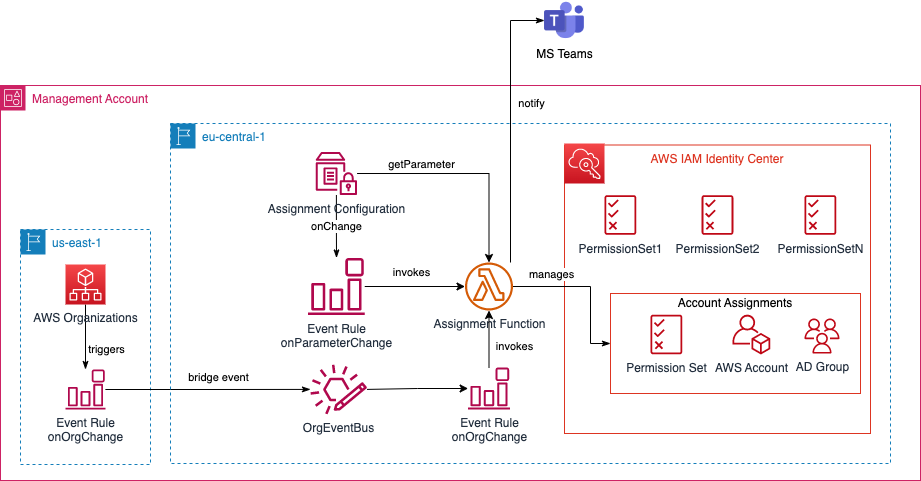This CDK project contains all resources relating to automation of permission management for human users via the AWS IAM Identity Center service (formerly AWS SSO). With AWS IAM Identity Center, authentication and authorisation were realised via identities from the identity pool configured in AWS IAM Identity Center.
In the project, the required policies are provisioned in so-called Permission Sets and rolled out to the desired accounts via automation. This rollout is also called assignment in the AWS IAM Identity Center. An assignment consists of:
- Permission Set (with the desired IAM Policy for the IAM Role)
- AD Group
- AWS Account
In the provided solution, only AD groups are used in assignments.
The CDK stack first rolls out the permission sets that have been created. In addition, a Lambda function is deployed that takes care of the automated management of the assignments. There is a configuration for this, which is stored in a ParameterStore parameter. The function is triggered by event rules from AWS EventBridge. If an assignment is created/deleted successfully or incorrectly, a message is sent to an MS Teams channel configured via Webhook.
The individual components are described below.
A permission set is basically a set of managed and custom IAM policies, which you can assign to a user/group in an account. In the lib/permission-sets-stack.ts file you will some examples for provisioning permission sets in the managment account.
The configuration for assignments is in the values file. This is the core for automating the management of assignments. Currently, an AD domain is supported for the AD groups. This must be specified via the ADDomain property. The configuration contains the following configuration sections:
GlobalAssignmentsFor assignments of PermissionSets that are required in all accounts.OuAssignmentsFor assignments of PermissionSets required in accounts of a specific OU.AccountAssignmentsFor assignments of PermissionSets that are required in specific accounts.
Example:
AssignmentConfiguration: {
AdDomain: "yourorg.com",
GlobalAssignments: [
{
AdGroupName: "AD-GROUP-CLOUD-ADMINS",
PermissionSet: "MyRole1PermissionSet"
}
],
OuAssignments: [
{
OuName: "FinanceUnit",
Assignments: [
{
AdGroupName: "AD-GROUP-FINANCE-OPS",
PermissionSet: ""
}
]
}
],
AccountAssignments: [
{
AccountName: "MyOrgSecurityAccount",
Assignments: [
{
AdGroupName: "AD-GROUP-SEC_AUDIT",
PermissionSet: ""
}
]
}
]
}The GlobalAssignments section is an array that requires the PermissionSet name and the AD group name per entry (without domain name).
For the OuAssignments, one array entry is displayed per OU (OrganisationalUnit), which contains another array with the assignments. The OuName must be entered here.
For the AccountAssignments, one array entry is displayed per OU (OrganisationalUnit), which contains another array with the assignments. The AccountName must be entered here.
The automation of the management of account assignments is realised via a Lambda function AssignmentFunction. The function is triggered by the following event rules of AWS EventBridge:
- Change in the parameter (and thus the configuration)
- Change in the AWS organisation (account creation, account deletion, new OU creation, etc.).
Thus, any change in the assignment configuration or change in the AWS Organisation can trigger an update of the assignments. The Lambda function works as follows:
- First, the configuration is loaded from the parameter store.
- A desired list of assignments is created from the configuration (desired assignments).
- An actual list of assignments is created (current assignments).
- From both lists, the assignments to be created and deleted are determined.
- All desired Assignments will be created
- All desired Assignments will be deleted
Since the deletion/creation of assignments runs asynchronously, each assignment is deleted one after the other and the status is checked via a separate SDK call. Only when the status is no longer IN_PROGRESS is the next assignment created.
- task to run the different tasks specified in
Taskfile.yml - aws CLI Version 2.x
- cdk Version 2.x
- jq is used in our
taskconfiguration - docker or esbuild for Transpiling the Lambda Function
For deployment, a valid session must first exist in the management account for your shell. Deployment then is initiated via:
task deploy
You can configure this project with e.g. sample.ts in folder values.




